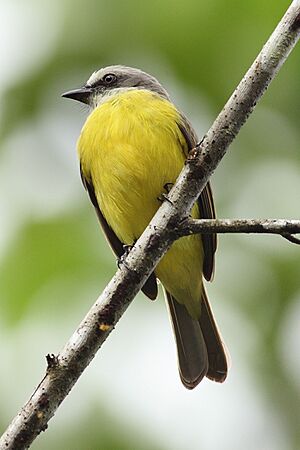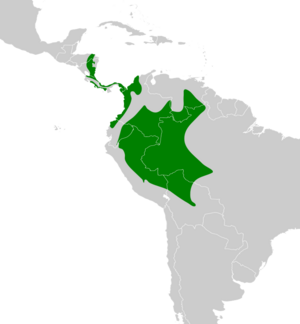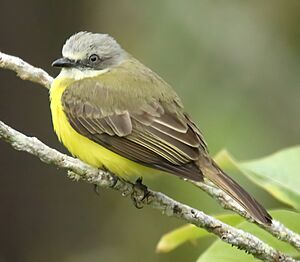Grey-capped flycatcher facts for kids
Quick facts for kids Grey-capped flycatcher |
|
|---|---|
 |
|
| Conservation status | |
| Scientific classification | |
| Genus: |
Myiozetetes
|
| Species: |
granadensis
|
 |
|
The grey-capped flycatcher (scientific name: Myiozetetes granadensis) is a small passerine bird. It belongs to a big bird family called tyrant flycatchers. These birds are known for catching insects while flying.
Contents
About the Grey-capped Flycatcher
Where They Live
These flycatchers live in warm places. You can find them from eastern Honduras all the way south to northwestern Peru. They also live in northern Bolivia and western Brazil. They like open areas with some trees, like farms, pastures, and open woodlands.
What They Look Like
The grey-capped flycatcher is about 16.5 to 18 centimeters (about 6.5 to 7 inches) long. It weighs around 26 to 30 grams, which is about the same as a few quarters. Its head is grey, and it has a faint stripe near its eye. Male grey-capped flycatchers have a special secret! They have a bright red stripe on top of their head, but it's usually hidden. Their back is olive-brown, and their wings and tail are brown. Their wings and tail have only a little bit of reddish-brown color on the edges. Their belly is yellow, and their throat is white. Young grey-capped flycatchers don't have the hidden red crown stripe. Their wing and tail feathers have more chestnut (reddish-brown) edges. This bird looks a lot like another bird called the social flycatcher. The easiest way to tell them apart is that the social flycatcher has strong black and white patterns on its head.
Sounds They Make
Grey-capped flycatchers have a sharp, nose-like call that sounds like kip. When the sun comes up, their song is a series of kip, kip, kip, k’beer sounds.
What They Eat
These birds are great at catching insects! They often sit on an open branch in a tree. When they see an insect flying by, they quickly fly out to catch it in mid-air. Sometimes, they also hover in the air to pick small berries from plants.
Reproduction and Nests
The female grey-capped flycatcher builds the nest. It's a large, roofed structure made of stems and straw. They often build their nests in bushes, trees, or even on buildings. For extra protection, they often build their nests very close to the nests of wasps, bees, or ants. They might also build near the nest of another type of flycatcher, like the social flycatcher. This helps keep their eggs safe from predators. The nest is often built near or over water. A female usually lays two to four dull white eggs. These eggs often have brown or lilac-colored spots. They lay their eggs between February and June.



